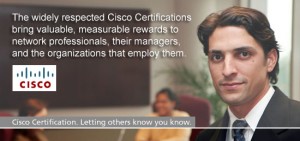CCIE is also known as PH.D of Endless Networking
CCIE Certification Programs are the expert-level certification is the Cisco Certified Internetwork Expert (CCIE). It is the highest level of professional certification that Cisco provides. There are fiv e active CCIE tracks. As of June 26, 2009 there are 20,003 people with active CCIE certifications in the world.
e active CCIE tracks. As of June 26, 2009 there are 20,003 people with active CCIE certifications in the world.
Cisco began its CCIE program in 1993 originally with a two day lab format; later changing it to the one day format used today. Less than 3% of Cisco certified individuals attain CCIE certification and spend thousands of dollars and 6 months of time for passing. Many candidates build mock-labs at home using old Cisco equipments, selling it again to other candidates after passing. Alternatively candidates may rent “rack time” online and practice lab scenarios on Cisco equipment hosted on the Internet for that purpose.
Cisco refers to the CCIE as the “most respected IT certification” and from 2002 to 2005 it was voted as such in CertCities magazine. It has also been voted the most technically advanced IT certification by CertMag, and is generally reported as the highest salaried certification in IT salary surveys.
The CCIE is comprised of a written exam and a “lab” exam (each in the specific area of the chosen track). The written exam is required to take the lab exam, and has a cost of $350 USD per attempt. After passing the written exam, the candidate has eighteen months to take the lab exam. If the first attempt is unsuccessful the candidate has three years from the date the written exam was passed to successfully complete the lab. If the candidate does not pass the CCIE lab in that period, he must pass the CCIE written exam again before making additional attempts at the CCIE lab exam. As many attempts can be made to pass the lab exam for up to three years after passing the written, so long as the first attempt is within 18 months. There is a minimum waiting time of one month between two attempts.
The CCIE Lab is currently $1,400 USD per attempt and is offered only at ten Cisco lab exam locations worldwide. The locations are Bangalore; Beijing; Brussels; Dubai; Hong Kong; Research Triangle Park, NC; San Jose, CA; São Paulo; Sydney; and Tokyo. Some CCIE tracks do not have lab exams available at all locations. For example, the Storage Networking lab is available only at the Research Triangle Park, NC and Brussels locations. In addition, according to a survey by Cisco the average cost to prepare for CCIE certification is $9,050 as of April 2006, spent mostly on practice equipment and self study material.
The lab is an eight hour hands-on exam designed to demonstrate that the candidate not only knows the theory, but is also able to practice it. Many prospective CCIEs need multiple attempts to pass the lab exam.
There are no formal prerequisites for the CCIE exam, but Cisco recommends one has at least 3–5 years experience in networking before attempting to become a CCIE. CCIE was the first Cisco certified qualification, and as such there were no other certifications that could be taken prior. The development of the associate and professional certifications was due to recognition of the fact that a CCIE is overkill for many networking personnel, and also for the vast majority of businesses who employ such people, and that certifications needed to be offered at lower levels. Despite the development of the lower certifications, Cisco has chosen not to make them formal requirements for the CCIE certification.
It is possible to hold multiple CCIE certifications. This is done by passing both the written and the lab exam in a particular track. As of September 9, 2008, there are 1,729 individuals who hold multiple CCIE certifications. Of those, 274 hold three or more CCIE certifications.
CCIE Numbering and Recertification
Upon successful completion of the hands on lab exam, a new CCIE is awarded a CCIE number. The first CCIE number allocated (in 1993) was 1024, and has increased incrementally from there. A lower number indicates that the CCIE was awarded some time back; a higher number indicates a more recently awarded certification. As of July 2009, the highest CCIE number allocated was just under 25000.
Number 1024 was allocated to the first CCIE lab location, rather than to an individual, and featured as a plaque at the entrance to the lab. Number 1025 was awarded to Stuart Biggs, who created the first written exam and first lab exam. The first person to pass both CCIE Lab exams was Terrance Slattery, who was consulting to Cisco at the time when the lab was being devised. Terry Slattery (CCIE 1026) was therefore the first CCIE who passed both exams, and the first CCIE who was not an employee of Cisco.
Any CCIE who obtains further CCIE training, is not awarded any further numbers, the new CCIE certification is awarded under the same number as the original.
Every two years a CCIE has to take a CCIE written test to retain the certification (known as recertification). If this is not done, the CCIE is then said to be in suspended status. The CCIE certification is not recognised by Cisco as current at this point. After one further year, if a written test has not been undertaken and passed, the CCIE is then revoked. The CCIE certification can then only be re-gained by taking the written exam and lab exam from scratch.